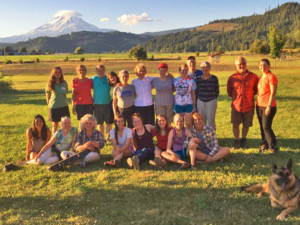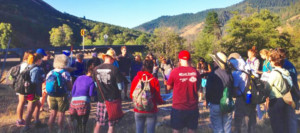“Currently, we are at a crossroads in our nation and the experience of the pilgrimage echoes in the hearts of those who seek social and environmental change, demanding that we recognize that the walk continues long after the physical road ends.” – Marielle McKenna
By Lynne Davidson. Jan. 23, 2017. “Silence. That’s how each day of walking begins. Whether in a group or alone, people focus on their own heartbeat, the sound of their shoes against the ground, and their thoughts for the day that stretches ahead.” That’s Marielle McKenna, 25, remembering last summer’s Camino del Rio (River Walk).

[/media-credit] Camino del Rio walkers on the Klickitat Trail
Inspired by the famous Camino de Santiago pilgrimage in Spain, Patrick and Becki Rawson developed a uniquely Columbia Gorge version of this spiritual journey. Beginning in 2015, they organize a five-day Camino (walk) the third week in July through some part of the Columbia River Gorge.
The pilgrimage can accommodate up to 50 participants (not all would have to partake in the full 5-day trek). Each walker pays a $10 per day donation to defray expenses of food and lodging. Like its namesake, the walk is a spiritual journey, but the Rawsons welcome people of any or no faith. They invite participants to explore a deeper connection with the Gorge’s beautiful landscape. “In doing so, we open ourselves to the inner and outer journey of walking more gently on our planet,” Patrick says.
“As we strive to deepen our sense of place,” Becki says, “we allow the land, mountains and rivers to transform us into more compassionate and responsible beings.”
The first pilgrimage took 35 people from Odell to Celilo Village, recalling the struggle and teachings of Native Americans who brought reverence on their walks across this land.
On the 2016 pilgrimage, Camino del Rio, 45 participants followed riverways, beginning at the White Salmon River near Trout Lake, Washington and ending five days, and 70 miles later, at the confluence of the Klickitat and Columbia Rivers in Lyle. The walkers ranged in age from a three month-old infant carried on her mama’s chest to a 69-year old urban blueberry farmer.

[/media-credit] Pilgrims gathered the first day at Trout Lake Abbey. The author in the back row, fourth from the left, next to Patrick Rawson.
THE ROUTE VARIED throughout the days, meandering at times along a dusty Forest Service road, and at other times along rocky woodland trails, beside creeks or on the shoulder of a paved street.
“There’s something very special about walking in the places where people generally would drive,” recalls Tina Castanares, 67, of Odell, who walked both years. “It’s like crossing the ocean in a ship instead of flying over it in an airplane. Plus, walking for multiple days slows life down in an important way. Sharing simple pleasures, sharing scenery, sharing conversation—these make for outstanding fellowship, unequalled.”
Pat Hunter from Portland, Oregon was the oldest walker at age 69. For her the pilgrimage was an opportunity to enjoy “an intergenerational group, the simplicity of walking in the Columbia Gorge beauty, and the relationship with people and small communities that we encountered as we walked.”
The Camino by design is a challenge. “The physical aspect of walking for five days was wearing,” admits Marty Lastowski, 56, of Palo Alto, California. “I got blisters and sunburned. And often the heat intensified the fatigue from walking so long without shade.”
While the days could be grueling, the walkers also described a feeling of oneness with nature they would have missed riding by car.
The first day of the 2016 Camino began in a shady forest where pilgrims carrying flashlights and jackets, explored the Ice Caves of Trout Lake, playfully spooking one another, their shrieks piercing the air, as vehicles lumbered by, unaware.
There were crisp 40-degree mornings when the skies echoed with the chirruping of gray jays and the distant screech of a red-tailed hawk that quickly morphed into 90-degree afternoons, when a hat was the only reprieve from a scorching summer sun. One walker improvised additional sun protection by layering a white t-shirt beneath his hat to further cover his neck and shoulders on the shadeless stretches. At one bend in the trail, pilgrims recall being bombarded with a cacophony of crickets chirping in the underbrush, unheard by passing cars.
BY WALKING 10-15 miles a day, the pilgrims increased their environmental awareness, as Maza Brady, 24, of Hood River discovered. “I’ve lived in the Gorge for years,” Brady says, “but had never been to Trout Lake. It’s beautiful there! There were wildflowers by the road and the view of Mt. Adams as we walked along was stunning! Finding awe in nature was my favorite thing.”
Having limited available water sources along the route itself, meant support vehicles were needed at times to cache water along the drier stretches. As hot and thirsty walkers reached these caches, gratefully refilling their water bottles, there developed a sense of the sacredness of water. This growing reverence for water was deepened each afternoon as the walkers jumped into frigid rivers or creeks, to escape the day’s heat.
Each afternoon, as weary pilgrims reached that day’s destination, they kicked off sweaty shoes and socks, peeled off layers of moleskin and bandages, and massaged oils into blisters.
Nights were spent in pre-arranged sleeping accommodations: the Trout Lake Abbey, a school in Wahkiacus, the Glenwood Community Church, and on the final night in the newly opened Klickitat Community Center.
The Rawsons scheduled educational forums each evening. A retired USFS employee gave a presentation on the Mt. Adams Wilderness, a stargazing event took place another evening lead by a local science teacher, a migrant worker read poetry aloud, and stories were shared with a Native American perspective.
Mornings began with the rich smell of coffee brewing as pilgrims sauntered into a common area to share a continental style breakfast. After packing lunches and filling water bottles, the walkers hoisted daypacks onto their backs. The remaining food items, sleeping bags and personal luggage were then loaded into the shuttle vehicles driven by volunteers who drove from one night’s accommodation to the next.

Lynne Davidson Morning reflection along the Klickitat Trail
Before leaving each day, pilgrims then gathered in a circle outside, huddling together in the chilly dawn. Someone offered a reflection. A prayer lifted. A song sung. Recognizing that throughout history walking has been a means of peaceful protest, a journey to safety, a spiritual quest—people felt a symbolism and a sacredness to the Camino walking with, walking beside, walking for others.
AT THE COMPLETION of this Camino, the pilgrims felt a deepened reverence for the Gorge and a need to preserve our waterways and natural resources. On the final day, participants walked the Klickitat Trail, marveling at the deep canyon walls carved by the Klickitat River. They watched Native Americans casting fishing nets from the bank, took photos of bald eagles circling overhead, and ended the Camino del Rio by cliff-jumping and swimming in the Columbia River.
“To walk is to treasure,” McKenna says. “Currently, we are at a crossroads in our nation and the experience of the pilgrimage echoes in the hearts of those who seek social and environmental change, demanding that we recognize that the walk continues long after the physical road ends.”





